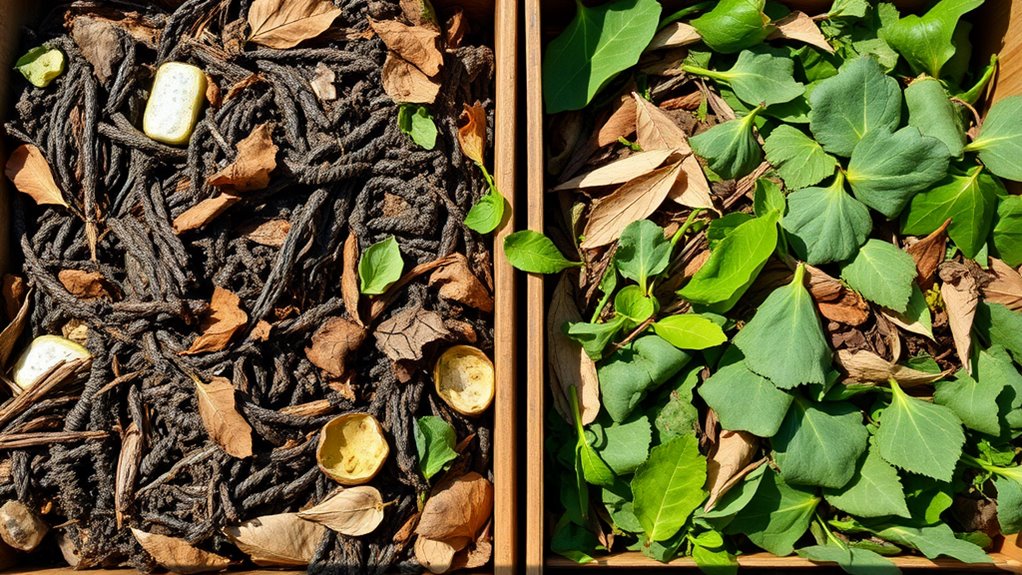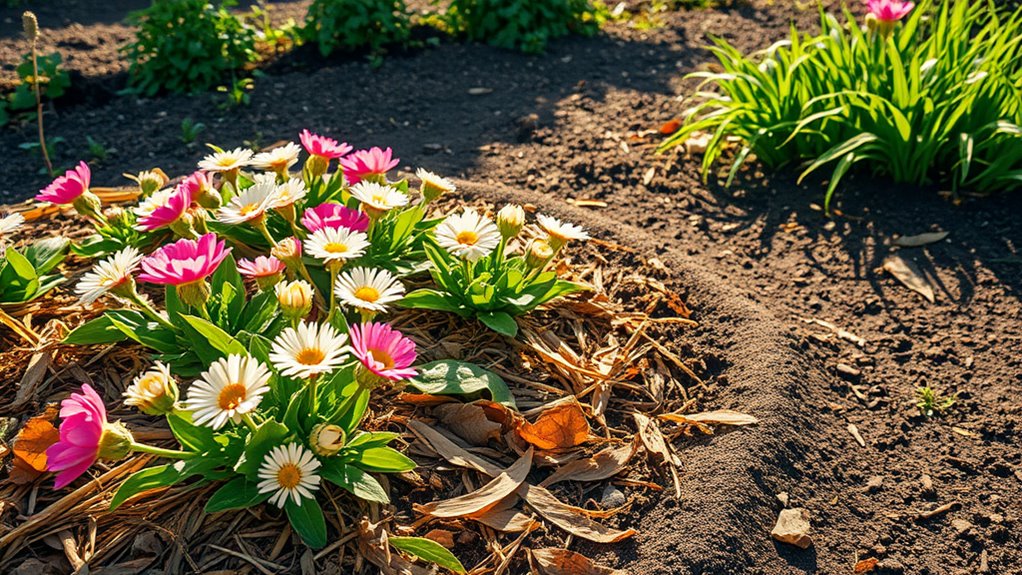The Compost Mistake That Almost Ruined My Garden
You’ve probably made the same composting blunder I did: overloading your pile with wet greens like kitchen scraps without enough dry browns, turning it into a soggy, smelly mess that attracted pests and stunted your plants’ growth. That imbalance caused sour odors, weak roots, and yellowing leaves, nearly wrecking my garden. Master moisture, aeration, and material balance, and you’ll uncover tips for a resilient setup that keeps everything flourishing.
Key Takeaways
- Imbalanced compost with too many greens can create excess moisture, leading to pests and poor decomposition.
- Signs of composting errors include sour smells, swarming flies, and lack of heat, indicating potential garden damage.
- Compost mistakes like inadequate aeration stunt plant growth, causing yellowing leaves and weak roots.
- Quickly fix problems by assessing the pile, adding browns, and turning it for better balance and aeration.
- Prevent future issues by maintaining a 2:1 browns-to-greens ratio and monitoring moisture weekly for healthy compost.
The Overlooked Composting Error
While you’re composting kitchen scraps to enrich your garden, you might be ignoring a subtle mistake that undermines your efforts.
One common composting error is adding too much wet material, like fruit peels, without enough dry browns, such as leaves or paper. This imbalance creates a soggy pile that stifles decomposition and invites pests.
To fix this, you actively balance your greens and browns—aim for a 2:1 ratio—and turn the heap regularly for airflow.
Avoid overwatering; let it stay moist, not drenched. These simple adjustments prevent composting errors and boost nutrient-rich soil effectively. By properly managing your compost, you can transform kitchen scraps into garden gold.
From the lessons learned in my own gardening trials, applying these tips can help safeguard your compost pile from similar setbacks.
Early Indicators of Trouble
You spot early indicators of trouble in your compost pile when imbalances persist, like a sour smell signaling excess moisture or a swarm of flies hinting at too many greens. Other signs include a pile that’s not heating up, indicating insufficient nitrogen, or one that’s too hot from excess greens. You might also notice mold growth, suggesting poor mixing, or an ammonia odor, pointing to high protein. Watch for these to maintain balance. For instance, addressing these issues can lead to creating nutrient-rich compost from your kitchen scraps.
Addressing these indicators promptly can help you achieve rich, healthy soil.
| Early Sign | What It Means |
|---|---|
| Sour smell | Excess moisture |
| Flies swarming | Too many greens |
| No heat | Insufficient nitrogen |
How the Mistake Impacted My Plants
When you make a compost mistake in your garden, it stunts your plants’ growth, leaving them smaller and weaker than they should be.
You’ll notice that the roots struggle to develop properly, robbing the plants of essential nutrients.
Additionally, leaves become damaged, showing yellowing or spots that signal underlying health issues. To prevent this, consider simple ingredient swaps for a more efficient decomposition process.
However, implementing a simple weekly routine can help produce black gold soil to nourish and strengthen your plants.
Growth Stunted
The compost mistake directly stunted my plants’ growth, turning what should have been vibrant shoots into weak, underdeveloped stems.
You might face similar issues if compost imbalances nutrients, so here’s how it affected mine:
-
Seedlings emerged slowly, delaying your garden’s progress and reducing overall vigor.
-
Stems grew shorter and thinner, making plants more susceptible to wind damage.
-
Root systems expanded poorly, limiting water and nutrient uptake for sustained health.
-
Flowering was postponed, cutting back on potential yields and garden enjoyment.
Spot these signs early to correct compost use and boost your plants’ potential.
Leaves Damaged
Improper compost use also ravaged your leaves, causing yellowing and spots that compromised plant health. You’ll see how nutrient imbalances from poor compost led to weakened defenses, making plants more vulnerable to pests and diseases. To illustrate the damage:
| Symptom | Cause | Effect |
|---|---|---|
| Yellowing | Excess nitrogen | Reduced photosynthesis |
| Spots | Pathogenic buildup | Increased leaf drop |
| Wilting | Improper moisture | Overall plant decline |
Address this by testing compost pH and balancing inputs to restore vitality quickly.
Immediate Steps to Fix the Problem
If you’ve made a compost mistake in your garden, start by assessing the damage quickly to identify affected plants and soil.
Then, adjust soil conditions right away by adding amendments like lime or organic matter to restore balance.
Finally, rebuild your compost pile with the right mix of greens and browns to prevent future issues. For busy individuals, adopting low-effort methods can help maintain a healthy garden with minimal time investment.
Additionally, incorporate kitchen scraps from your kitchen waste to further enhance the nutrient content and support sustainable practices.
Assess Damage Quickly
Once you’ve identified a compost mistake, quickly inspect your garden for visible issues like wilting plants or foul-smelling soil. This step helps you gauge the extent of damage before taking action.
-
Examine plants closely: Check leaves for discoloration or stunted growth to spot early stress signs.
-
Probe the soil: Feel for unusual moisture levels or textures that indicate imbalance.
-
Scan for pests: Look for insects or unusual activity that might’ve been triggered by the mistake.
-
Note affected areas: Mark spots with issues to track patterns and prioritize your response.
Adjust Soil Conditions
After assessing the damage from your compost mistake, you’ll quickly adjust soil conditions to restore balance and protect your plants.
First, test soil pH with a reliable kit; if it’s too acidic, add lime to neutralize it. For overly alkaline soil, incorporate sulfur.
Aerate compacted areas by gently turning the topsoil to improve drainage and oxygen flow. Add balanced organic amendments like well-rotted manure, avoiding fresh materials.
Monitor moisture levels closely, watering evenly to prevent root rot. Track changes weekly to ensure your garden rebounds effectively.
These steps will safeguard your plants’ health promptly.
Rebuild Compost Pile
Rebuild your compost pile immediately to correct the earlier mistake and restore a healthy decomposition process.
You’ll avoid future problems by starting fresh with the right setup.
-
Remove old materials: Clear out any contaminated or overly wet layers to eliminate pests and odors.
-
Balance your greens and browns: Add equal parts nitrogen-rich greens (like kitchen scraps) and carbon-rich browns (such as leaves) for optimal decomposition.
-
Aerate and moisten: Turn the pile regularly and add water to keep it damp but not soggy, promoting beneficial microbes.
-
Monitor progress: Check temperature and moisture weekly, adjusting as needed to ensure even breakdown.
Essential Elements for Proper Composting
To master composting and avoid common pitfalls, you’ll need to balance key elements like carbon-rich “browns” (such as leaves), nitrogen-rich “greens” (like kitchen scraps), adequate moisture, and proper aeration. These form the foundation of a thriving pile; incorporate them wisely to prevent issues. Small spaces can still support effective composting with these principles, making it accessible for urban gardeners.
| Element | Role |
|---|---|
| Browns | Supply carbon for energy |
| Greens | Deliver nitrogen for decomposition |
| Moisture | Maintains necessary wetness |
| Aeration | Ensures oxygen for microbial work |
Master these basics, and you’ll build robust compost effortlessly. By adopting these methods, you can explore sustainable practices to enhance your garden’s health and reduce reliance on commercial products.
Balancing Moisture and Aeration
While you’ve mastered the essential elements like browns and greens, balancing moisture and aeration keeps your compost pile thriving. This ensures efficient decomposition, prevents foul odors, and maintains healthy microbes for nutrient-rich soil.
-
Test moisture levels: Squeeze a handful; it should feel damp like a wrung-out sponge, not soggy or dry.
-
Aerate regularly: Turn the pile every few days with a pitchfork to introduce oxygen and prevent compaction.
-
Adjust as needed: Add water if it’s too dry, or mix in dry leaves if it’s too wet to restore balance.
-
Monitor indicators: Watch for steady heating and a fresh smell, signaling your pile is decomposing properly.
To further support your composting efforts, incorporating mulch can aid in moisture retention for overall garden health. By incorporating mulching, you can achieve consistent moisture throughout the growing season, transforming your garden into a thriving oasis.
Common Materials to Avoid
Even though you’ve nailed the fundamentals of composting, you’ll want to steer clear of certain materials that can attract pests, foster diseases, or slow decomposition.
Don’t add meat, dairy, or oily foods, as they draw rodents and flies while creating foul odors. Avoid diseased plants or weeds with seeds, which might spread pathogens or invasive species through your pile.
Steer clear of pet waste and chemically treated wood, too; these can introduce harmful bacteria and toxins that disrupt the process.
Building a Resilient Compost System
Creating a resilient compost system means your pile will thrive through challenges like weather shifts or material imbalances.
You’ll build one by focusing on balance and regular upkeep to avoid disruptions.
-
Monitor moisture: Keep your pile damp but not soggy, checking weekly to prevent drying or waterlogging.
-
Balance materials: Maintain a 2:1 ratio of browns to greens, adding layers as needed for steady decomposition.
-
Aerate frequently: Turn the pile every few days using a fork to introduce oxygen and speed up breakdown.
-
Insulate properly: Use covers or bins to shield from rain or cold, ensuring consistent temperatures for resilience.
Tips for Long-Term Garden Health
Building on your resilient compost system, you maintain long-term garden health by adopting simple, ongoing practices that sustain soil vitality and plant resilience. Focus on mulching to retain moisture, rotating crops to prevent depletion, testing soil annually for nutrients, monitoring pests naturally, and scheduling deep watering. These steps build a thriving ecosystem. Here’s a practical guide to implement them:
| Practice | Key Benefit |
|---|---|
| Mulching | Retains moisture |
| Crop Rotation | Prevents soil exhaustion |
| Soil Testing | Balances nutrients |
| Pest Monitoring | Reduces chemical reliance |
| Deep Watering | Boosts root strength |





